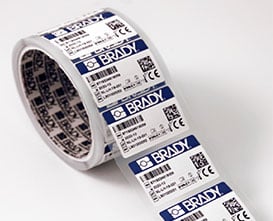Speed up train composition identification for faster maintenance processes.
Customisable RFID labels, scanners, and software for efficient tracking.
Faster identification and improved maintenance with real-time data access.
Rail passenger and freight transporters can increase locomotive and wagon uptime by easily identifying train composition with RFID labels and scanners
Challenge: Increase Train Identification Speed
Checking train composition in the field is in many cases still a manual process that involves locating and recording wagon or part numbers, which can be difficult to read. Increasing train identification speed is crucial for enabling faster reactive and proactive maintenance, ultimately helping to avoid delays for both passengers and freight.
Solution: RFID Labels, Handheld, and Fixed Scanners
Wagons, locomotives, and their parts can be identified with reliable, fully customizable RFID labels. These labels, made from durable polyester, stay attached and remain legible in harsh environments and outdoor conditions. Additional materials are available for specific use cases to ensure optimal reliability.
Fully customizable RFID labels
Brady provides customizable L-2588-26C UHF RFID labels with a read range of up to 11 meters. Additionally, L-2588-25B UHF on-metal RFID labels offer a 3-meter read range when applied to metal surfaces. HF or NFC on-metal RFID labels are also available for close-range reading.
Faster maintenance with RFID labels and handheld scanners
RFID labels provide wagons or parts with unique, standardized identifiers that can be read from a distance using UHF RFID scanners or up close with NFC-enabled smartphones. These identifiers can be linked to a company ERP system via asset management software, enabling maintenance teams to quickly access an item's maintenance history, mileage, technical documentation, re-order codes, and other essential information for efficient repairs.
Proximity alerts via the software can help locate parts even faster.
Errors related to manually copying serial numbers or other identifiers can be avoided. Relevant documentation can become available immediately on handheld scanners, and interventions can be added easily to the asset’s maintenance history. Similar assets with the same make and model, or produced in the same lot, can be highlighted quickly for predictive maintenance. Steps on how to solve the problem can become accessible for other maintenance teams so they can intervene even faster.
Print and program RFID labels at your premises
RFID labels can include human-readable and datamatrix codes. Printers capable of printing and programming UHF or HF NFC RFID labels simultaneously are available for use at any location.

Results: Faster Train Identification with RFID Labels and Scanners
Maintenance teams can now identify train composition and the specific wagon or locomotive for service without needing to visually check identification numbers. These identifiers can be scanned from a distance, providing immediate access to all relevant maintenance information. Intervention data can be added to the wagon's maintenance history, and similar wagons can be flagged for efficient predictive maintenance.
